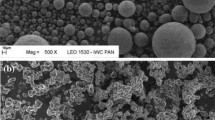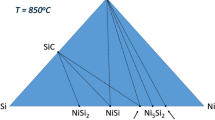Abstract
Features of sintering in argon and structure formation of materials of the systems (TiN, ZrN) – Ni are studied. It is shown that sintering is accompanied by the release of nitrogen from nitrides, reciprocal dissolution of nickel in nitrides and also Ti and Zr in nickel, formation of nickel intermetallics, and an increase in the microhardness of solid phase grains. The main reason for the quite high porosity of sintered TiN – Ni and ZrN – Ni composites are the accumulation of nitrogen released from the nitrides within closed volumes with formation of closed pores. Sintering of materials is accompanied by the growth and faceting of solid phase grains due to dissolution and recrystallization through a liquid phase, and also an increase in metal phase content.
Similar content being viewed by others
REFERENCES
P. A. Boiko, Study of Conditions for Preparing Very Fine Nickel Powder and Alloys Based on It Strengthened with Transition Metal Carbides, PhD Thesis [in Russian], Kiev (1969).
B. N. Babich and I. V. Romanovich, “Effect of sintering temperature for powder compacts on the structure and properties of dispersion-strengthened nickel, ” Poroshk. Metall., No. 4, 29–33 (1975).
V. T. Bondar', “Behavior of titanium, zirconium and vanadium nitrides and their composites with nickelmolybdenum alloys, ” Poroshk. Metall., No. 4, 68–73 (1974).
V. T. Bondar', “Reaction of titanium nitride and its composites with nickel and Ni-Mo, ” Poroshk. Metall., No 8, 85–88 (1980).
O. N. Kaidash, “Features of sintering cermets based on titanium nitride, ” in: Reaction Processes at Phase Interfaces [in Russian], Inst. Sverkhtverdykh Materialov, Akad. Nauk UkrSSR, Kiev (1982).
M. Fukuhara and H. Mitani, “On sintering of TiNx-Ni binary mixed powder compacts, ” JSPM, 26, No. 4, 143–148 (1979).
M. Fukuhara, Tutsumi, and H. Mitani, “Some properties of TiNx-Ni powder compact sintering by using the Ni-plated composite powders, ” JSPM, 27, No. 1, 17–22 (1980).
F. F. Egorov and V. E. Matsera, “Compaction and structure formation during sintering of composite materials based on group IV-V transition metal nitrides. I. Sintering of composite materials of the system TiN-Cr, ” Poroshk. Metall., No. 9/10, 21–29 (1988).
F. F. Egorov, V. P. Smirnov, I. I. Timofeeva, et al., “Study of the reaction of titanium nitride with molten nickel, ” Adgeziya Rasplavov i Paika Materialov, No. 19, 59–64 (1987).
Ya. E. Geguzin, Physics of Sintering [in Russian], Nauka, Moscow (1969).
A. P. Savitskii, “Diffusion reaction of a melt with solid phase during sintering, ” Adgeziya Rasplavov i Paika Materialov, No. 21, 38–44 (1988).
I. N. Chaporova and K. S. Chernyavskii, Structure of Sintered Hard Alloys [in Russian], Metallurgiya, Moscow (1975).
F. F. Egorov, S. Yu. Koshkina, A. N. Shatokhin, et al., “Structure formation during sintering of heterophase TiN-Ni materials, ” Poroshk. Metall., No. 4, 25–30 (1990).
F. F. Egorov, E. N. Ivanov, and A. N. Shatokhin, “Structure and high-temperature strength of sintered TiN-Ni materials, ” Poroshk. Metall., No. 7, 80–83 (1990).
G. A. Vydrik and V. S. Kostyukov, Physicochemical Bases of the Production and Operation of Electrical Ceramics [in Russian], Énergiya, Moscow (1971).
D. Umber and D. Elliot, Problems of Contemporary Metallurgy [Russian translation], Moscow (1961).
F. Ya. Kharitonov and E. Ya. Medvedovskii, “Liquid-phase sintering of ceramic materials, ” Izv. Akad. Nauk SSSR, Neorgan. Materialy, 23, No. 2, 32–331 (1987).
G. V. Samsonov, A. D. Panasyuk, G. K. Kozina, et al., “Reaction of group IV metal carbides with metals of the iron family, ” Poroshk. Metall., No. 7, 66–70 (1972).
K. K. Strelov, Structure and Properties of Refractories [in Russian], Metallurgiya, Moscow (1982).
M. Hansen and K. Anderko, Structure of Binary Alloys, Vol. 2 [Russian translation], Metallurgizdat, Moscow (1962).
G. V. Samsonov and I. M. Vinnitskii, Refractory Compounds: Handbook [in Russian], Metallurgia, Moscow (1967).
G. V. Samsonov (ed.), Physicochemical Properties of Oxides: Handbook [in Russian], Metallurgia, Moscow (1978).
Author information
Authors and Affiliations
Rights and permissions
About this article
Cite this article
Matsera, V.E. Compaction and Structure Formation during Sintering of Composite Materials Based on Nitrides of Groups IV and V Transition Metals. Part 5. Sintering of Composite Materials of the Systems (TiN, ZrN). Powder Metallurgy and Metal Ceramics 42, 350–356 (2003). https://doi.org/10.1023/B:PMMC.0000004154.67060.c2
Issue Date:
DOI: https://doi.org/10.1023/B:PMMC.0000004154.67060.c2




